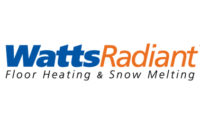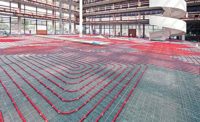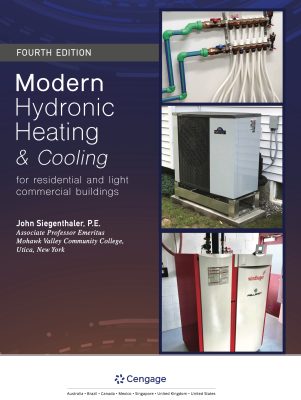The High-Altitude Army Aviation Training Site is located at Eagle/Vail Airport, just outside of Eagle, Colo. This facility is designed for the training of U.S. military and allied nations’ helicopter pilots, which focuses on high-altitude mountain flying and its special issues. It provides billeting, classroom training, airfield operations and helicopter maintenance.
The maintenance hangar is 16,100 sq. ft. and is heated by a radiant floor with heat recovery makeup air units that have heating coils only for tempering the outside air. The hangar also has extensive shops for working on all helicopter systems and components — from electronics to blade alignment servicing.
The system design for the radiant floor was initially based upon heating-only via six condensing boilers, supplying and heating hot water, by a variable flow secondary loop to a plate-and-frame heat exchanger. Later we at E Cube decided we could effectively supply radiant cooling to the space by installing a second plate-and-frame heat exchanger to the radiant loop, adding diverting valves for mode selection between a heating source or a cooling source. A separate open cooling tower and cool water pump provides cooled water to the plate-and-frame.
The Eagle facility is an 86° F dry bulb temperature (air temp) and coincident 57° wet bulb temperature design. The tower was designed for a 6° approach to wet bulb temperature and the plate-and-frame heat exchanger had a 2° approach, providing a 65° design supply temperature to the hangar floor. This indirect evaporative application is a self-regulating method to avoid condensation, since the cooling tower cannot exceed a supply temperature lower than the ambient outdoor dew point.
The tower fan has a variable-frequency drive and the building automation system is programmed to observe the ambient calculated WB to determine what cooling water temperature potential it has and drive the VFD to achieve that temperature, avoiding unnecessary brake horsepower work.
The ambient conditions in Eagle lend themselves to the use of high-volume, low-velocity air foil fans, such as those made by Big Ass Fans.
We determined that the “feeling of comfort” temperature needed to be raised. Referring to ASHRAE Standard 55-2004, it indicates a maximum operative temperature of 74° for people working at a low metabolic rate of met 2 at a clothing insulation level of clo 0.5. We reviewed the helicopter mechanics’ metabolic rate levels that ranged between a met 2 to met 3 (heavy mechanic work).
Various studies have been done to evaluate the use of air movement for cooling purposes. While air velocities up to 400 ft. per min. are utilized for this type of application, velocities over 200 fpm can cause loose paperwork to be disturbed and may not be applicable for this space. Studies indicate that an air velocity of 200 fpm results in a comfort level equivalent to an approximate 5.3°drop in ambient dry bulb temperature.
This increases to a drop of approximately 6.6°at 300 fpm. These values are for moderate-to-high activity levels (met 1.3 to met 3.0) and equal ambient air and mean radiant temperatures (a close approximation for a reasonably well-insulated, unconditioned space with minimal stratification).
Heating potential
We took into consideration the coordination between the radiant floor, the low-velocity air foil fan and the heat recovery makeup air unit. The hangar’s radiant floor required different fan speeds to accommodate the seasonal operation of the radiant floor. Simply put, the fan speed could degrade the radiant “heating potential” if the typical fan speed for destratification would have been utilized.
Radiant heating does not produce significant heated air, less than 20%, that would stratify in the higher reaches of the hangar space. Therefore, a minimum speed was selected in the heating mode. This will marginally enhance the air distribution effectiveness to the space but not degrade the radiant heating by forcing excessive air over the floor and occupants working on the helicopters. The excessive air flow would produce convective heat loss and stratify the air.
Table 6-2 in ASHRAE 62-2004 indicates the efficiency of the high bay system without ceiling fans would probably be close to 50%. The low-velocity air foil fan will improve ventilation effectiveness to approximately 100%.
The design ventilation rate for the maintenance hangar is 1.5 cu. ft. per min. per sq. ft. This is based on ASHRAE 62 exhaust guidelines for an automotive repair shop. ASHRAE does not require that the makeup air be 100% outside air. If fresh air requirements are determined by occupancy level, the estimated occupancy of 40 people would require outside air ventilation at approximately 0.2 cfm/ft.2 (based on similar space requirements).
The 100% outside makeup air for this space creates a significant excess of ventilation air. Therefore, even a very low effectiveness would create adequate ventilation. The 50% effectiveness without the air foil fan results in three times the required ventilation for the space. The increase in effectiveness delivered by the fan is a marginal improvement.
The airfoil fan is fixed at a summer mode speed of 53 Hz, which allows sufficient air movement, around 200 fpm. As noted earlier, this was to avoid blowing papers and other items around on the work surfaces as the aircraft mechanics worked on the machines. The radiant floor cool water temperature was trending at approximately a delta T of 8° to 12° raise. This was witnessed at an entering water temperature of 65°.
The main points are the use of the air foil fan to modify cooling temperatures while not degrading the heating effectiveness of the radiant floor. The fan operation will improve the air distribution effectiveness during the winter months when the doors usually remain closed. Outside ventilation air is dependent on the makeup air unit with the heat wheel that incorporates a return air damper to take care of any snow buildup on the heat wheel.
The whole training facility is controlled by an air foil fan for all the mechanical, electrical and plumbing systems. The radiant operations are fully automated and monitored on an hourly trend-logging basis. The 2014 summer months will be the first summer of stable operations, meaning the facility is in full use.
Data from the building automation system is being logged in and archived for verification of the operations and to adjust the engineering calculations we used in the design. We will conduct a comprehensive study of both the design engineering and the monitored data after this first summer of stable operations at the site.
The maintenance staff report positive responses to the operational comfort of the space, including space conditioning and indoor air quality. We are very proud to have been part of the project team that provided a world-class facility for our warriors to maintain and train for our security.
Author bio: Leonard Rozek is president of the engineering consulting company E Cube and Steve Guinard Sr. is an E Cube commissioning specialist. Boulder, Colo.-based E Cube provides commissioning and retro-commissioning services nationally.









